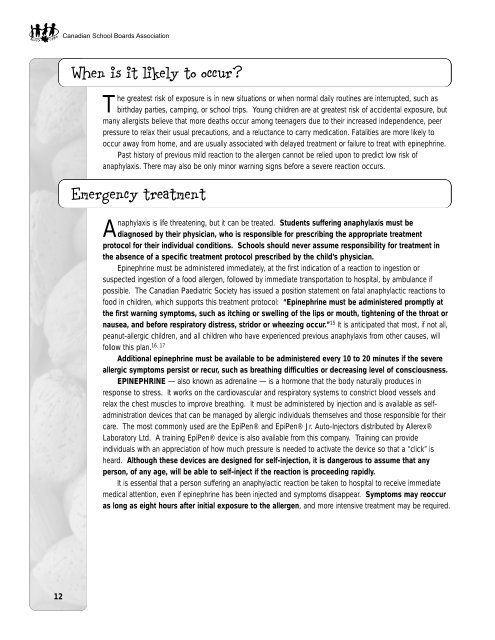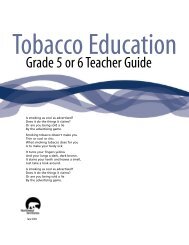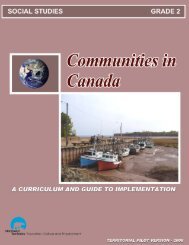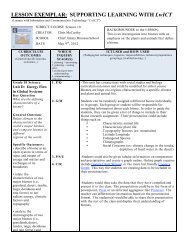Anaphylaxis: A Handbook for School Boards - Education, Culture ...
Anaphylaxis: A Handbook for School Boards - Education, Culture ...
Anaphylaxis: A Handbook for School Boards - Education, Culture ...
Create successful ePaper yourself
Turn your PDF publications into a flip-book with our unique Google optimized e-Paper software.
Canadian <strong>School</strong> <strong>Boards</strong> AssociationWhen is it likely to occur?The greatest risk of exposure is in new situations or when normal daily routines are interrupted, such asbirthday parties, camping, or school trips. Young children are at greatest risk of accidental exposure, butmany allergists believe that more deaths occur among teenagers due to their increased independence, peerpressure to relax their usual precautions, and a reluctance to carry medication. Fatalities are more likely tooccur away from home, and are usually associated with delayed treatment or failure to treat with epinephrine.Past history of previous mild reaction to the allergen cannot be relied upon to predict low risk ofanaphylaxis. There may also be only minor warning signs be<strong>for</strong>e a severe reaction occurs.Emergency treatment<strong>Anaphylaxis</strong> is life threatening, but it can be treated. Students suffering anaphylaxis must bediagnosed by their physician, who is responsible <strong>for</strong> prescribing the appropriate treatmentprotocol <strong>for</strong> their individual conditions. <strong>School</strong>s should never assume responsibility <strong>for</strong> treatment inthe absence of a specific treatment protocol prescribed by the child’s physician.Epinephrine must be administered immediately, at the first indication of a reaction to ingestion orsuspected ingestion of a food allergen, followed by immediate transportation to hospital, by ambulance ifpossible. The Canadian Paediatric Society has issued a position statement on fatal anaphylactic reactions tofood in children, which supports this treatment protocol: “Epinephrine must be administered promptly atthe first warning symptoms, such as itching or swelling of the lips or mouth, tightening of the throat ornausea, and be<strong>for</strong>e respiratory distress, stridor or wheezing occur.” 15 It is anticipated that most, if not all,peanut-allergic children, and all children who have experienced previous anaphylaxis from other causes, willfollow this plan.16, 17Additional epinephrine must be available to be administered every 10 to 20 minutes if the severeallergic symptoms persist or recur, such as breathing difficulties or decreasing level of consciousness.EPINEPHRINE — also known as adrenaline — is a hormone that the body naturally produces inresponse to stress. It works on the cardiovascular and respiratory systems to constrict blood vessels andrelax the chest muscles to improve breathing. It must be administered by injection and is available as selfadministrationdevices that can be managed by allergic individuals themselves and those responsible <strong>for</strong> theircare. The most commonly used are the EpiPen® and EpiPen® Jr. Auto-Injectors distributed by Allerex®Laboratory Ltd. A training EpiPen® device is also available from this company. Training can provideindividuals with an appreciation of how much pressure is needed to activate the device so that a “click” isheard. Although these devices are designed <strong>for</strong> self-injection, it is dangerous to assume that anyperson, of any age, will be able to self-inject if the reaction is proceeding rapidly.It is essential that a person suffering an anaphylactic reaction be taken to hospital to receive immediatemedical attention, even if epinephrine has been injected and symptoms disappear. Symptoms may reoccuras long as eight hours after initial exposure to the allergen, and more intensive treatment may be required.12
















